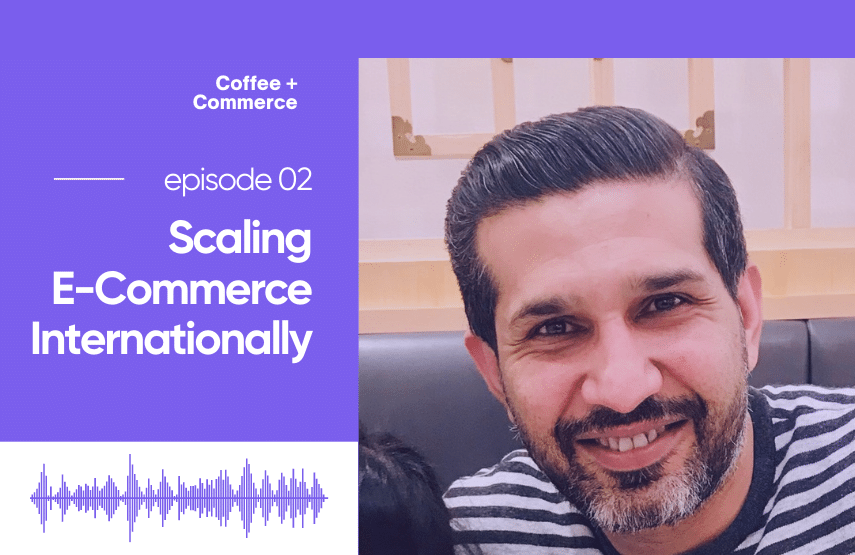Scaling E-Commerce Internationally with Furqan Munir [Podcast]

Furqan Munir is the product manager for our order management system (OMS) and was previously the Head of Technology for Groupon Goods in the EMEA from 2013 to 2019. Groupon’s expansion through international e-commerce contributed to $1B in sales processed by Groupon Goods in 2019. This accounted for half of Groupon’s total revenue that year.
We’re grateful that Furqan is part of our team at Fabric and, as creators of e-commerce software that helps businesses scale, we wanted to pick his brain on scaling e-commerce internationally. As e-commerce sales continue to grow faster in the EMEA and Latin America than in North America, there’s never been a better time for businesses to start building systems that support global customer experiences.
To get a crash course on how to plan and build for international e-commerce, listen to this Coffee + Commerce episode featuring Furqan and get key takeaways from the episode below.
Subscribe to Coffee + Commerce
[toc-embed headline=”Key Takeaways”]
Key Takeaways
[0:00] Can you use the same systems and infrastructure for international e-commerce?
- You can use systems and infrastructure from the “home playbook” but you must apply a high degree of localization.
- For example, in the United States, sales tax is added to the cart while in the United Kingdom and Europe it’s added to the price of the item. This has implications on changes made to existing systems, infrastructure, and playbooks.
[1:03] How are delivery and shipments different internationally?
- In the United States you have big 3PL providers that enable affordable, fast delivery of small and large items.
- In Europe it’s expensive to ship small items. Parcels that are smaller in size often don’t come with tracking and often default to standard 4-day shipping to decrease costs.
- Dropship is more popular in Europe and was used for about 60% of Groupon Good deliveries in this region.
- In the United States, the split between 3PL and dropship was about 70% and 30%, respectively.
- Trying to push 3PL didn’t make sense in Europe for Groupon Goods. The logistical cost of setting up warehousing was offsetting margins. By dropshipping items, costs were cut without any significant impact on customer experience.
[2:27] How do you scale SKUs in a new region? Which technology is needed?
- You must provide tools for vendors to easily come in and offer new assortments to your platform.
- Making custom tools for this in-house does not scale.
- Instead of dealing with spreadsheets, CSV files, and manual SKU entries, you must offer an admin UI for vendors. One of the tools that enables this is CommerceHub.
- The vendor UI connects to your e-commerce channels (i.e. publishing platforms) and newly added products can be reviewed by a contracted screening team.
- Providing a vendor UI can help you quickly go from 10,000+ SKUs to 100,00+ SKUs in a new region.
[4:44] If someone at a large organization is tasked with taking e-commerce international, what should they consider first?
- Look for the availability of efficiencies in the market, like the availability of various online payment providers. For example, in the Middle East, these efficiencies (i.e. infrastructure) do not exist.
- Look at the disposable income and interests of consumers in the market. For example, in Italy there’s a large appetite for fashion and luxury goods while in Germany there’s a larger appetite for high-end electronics.
- Look at logistical challenges. For example, in the Middle East there are no geo-locations and addresses can not be identified on Google Maps. Customers must also have a phone number for tracking purposes or else products can not be delivered. These challenges make deliveries more expensive than they are in the United States.
[7:15] How do you collaborate with teammates to launch international e-commerce initiatives?
- Perform exercises that include technology, product, and business teams. Perform breakouts on logistics, assortment, and other areas that envision how international e-commerce looks for a region years from now. Organize these exercises and breakouts into requirements.
- Consider putting together a vendor operations and operations migrations team. These teams work with technology teams and train vendors on how to add products and sell in new markets.
- Also consider putting together a change management team in the new market. This team ensures that the technology built for the new market is actually implemented and used. It also sets up reporting to measure KPIs and track success in the new market.
[9:04] Are microservices and “two pizza teams” needed for international e-commerce?
- Yes. At Groupon Goods there were individual teams focused on individual features and functionality like competitive pricing, benchmark pricing, personalization, and content.
[10:05] What are key metrics to track when expanding e-commerce internationally?
- Average fulfillment and logistics cost: you need to know the number of items purchased and shipped it takes to level out costs and make a significant margin.
- In-stock analysis: you need to quantify your replenishment and inventory process—how fast you are selling and how fast you can replenish inventory. You never want to be out of stock for your most in-demand products.
If you enjoyed this episode and breakdown, subscribe to Coffee + Commerce to get more expert insights on scaling e-commerce.

Content marketer @ fabric. Previously marketing @ KHON-TV and Paramount Pictures.